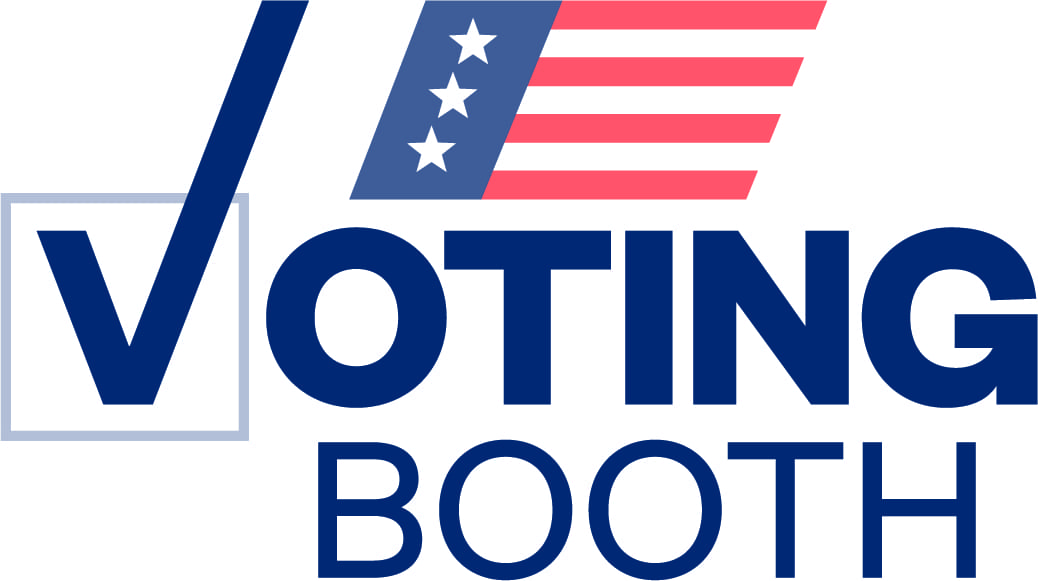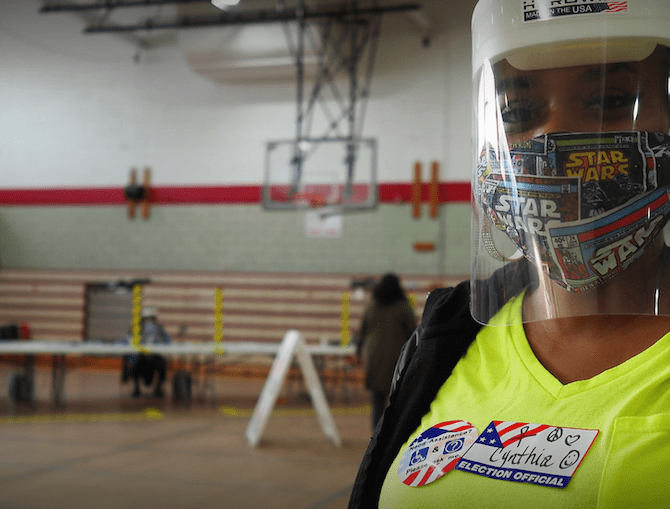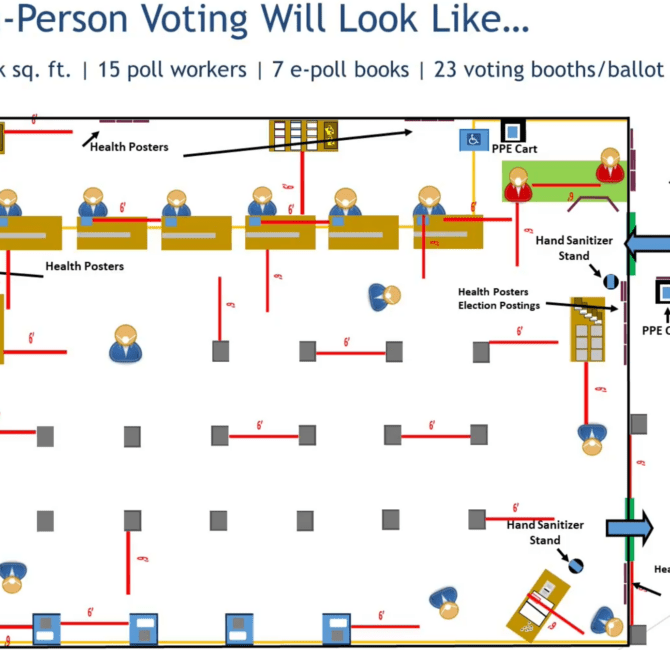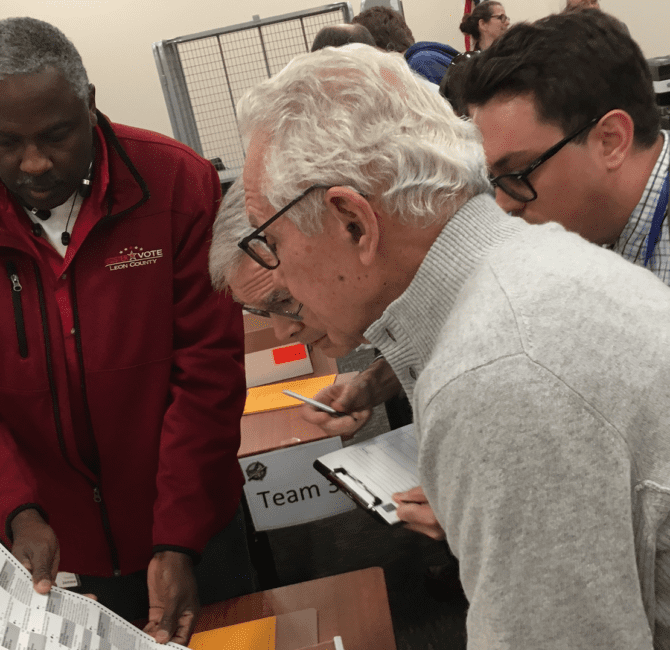Several States May Purchase Insecure Electronic Voting Systems
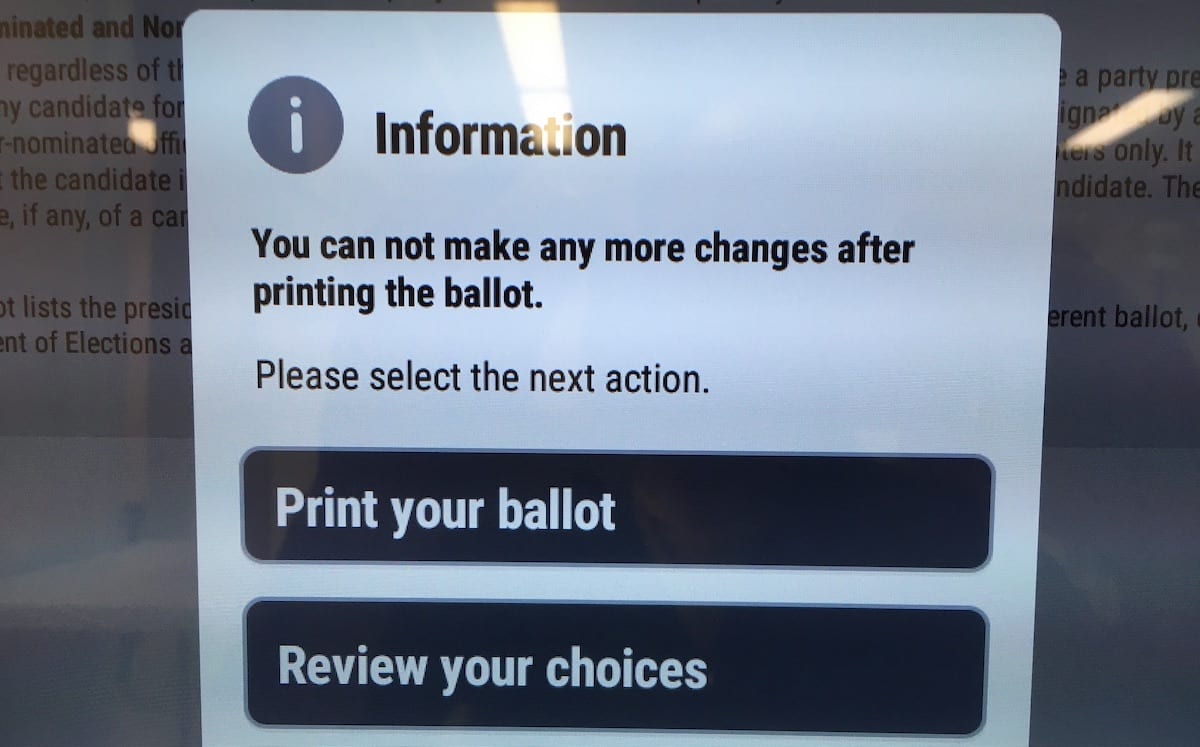
(Photo by Steven Rosenfeld)
For the first time in a dozen years, states are looking at replacing their aging voting machines and related computer systems. But a survey of the early legislative debates surrounding this prospect suggests that some states are not heeding advice from federal officials, academics and other experts saying that ink-marked paper-ballot systems are the wisest foundation for the most secure and verifiable elections.
This apparent dichotomy comes as states and the federal government have made an unprecedented effort to ramp up cyber-security precautions and training before 2018’s fall midterms, and as the voting machine industry is offering products that offer striking new options to make vote-counting more transparent and trustable.
The open question is whether legislators and election officials are looking to embrace newer technology and verification protocols, or whether they are drawn to more opaque systems that they have grown familiar with—and which are commercially available. As always is the case with 3,069 counties running America’s elections, there is a range of inclinations on voting modernization.
“I think there is a real variety. It varies according to the state,” said Marian Schneider, president of the Verified Voting Foundation and former Deputy Secretary of Elections and Administration in Pennsylvania. “I think there’s a risk that [some] states are going in that direction [sticking with legacy technologies]. I will say that especially in states that have used paperless DREs [direct recording equipment—or touch-screen computers] since 2002 and 2004. There’s a comfort level there that they don’t want to give up.”
In April, Congress appropriated $380 million to help states with cyber-security efforts in response to Russian meddling in 2016. While most of those funds have gone to hardening the computer systems that comprise the voting process—from voter registration databases to programming systems for the latest election to vote tabulators—some states have set aside some funds toward replacing their voting machinery. Even though Congress’s action is the first since 2002 for voting infrastructure, the appropriation is far from enough for states to fully modernize.
Still, the funding has prompted a handful of states to begin discussing replacing their infrastructure, giving a preview of what’s likely to come after the November midterms. That’s because the voting machinery used by most states is at least a decade old, and has known security vulnerabilities and operational limitations—such as DRE’s inability to conduct recounts because there’s no backup record if computer memory cards err.
These technological choices differ on several levels—from what voters see and interact with, to the ways that ballots are marked (by voters with pens or machines printing them out), to the ease of which ballots can be examined during close counts, to their capacity for post-election audits, to the operating costs over their lifetime use. Needless to say, some vendors have been lobbying officials in anticipation of once-a-decade sales.
Consider the range of the early legislative actions and discussions thus far:
• Georgia. The state is one of five nationally using entirely DREs. As its 2018 legislative session ended, an eleventh-hour bill to replace its 16-year-old machines failed after critics pointed out problems with its wording; the kind of equipment that would be allowed (the paper ballots produced would record voters’ choices with QR codes—dot matrix squares similar to barcodes—which activists said were not as transparent as ink-marked ballots); and an insufficient post-election process to audit the software’s accuracy. After the bill died, a commission was formed to report by the year’s end. At its first meeting in June, the top question seemed to be “whether Georgia should use pen-and-paper ballots or touchscreen machines to print ballots,” the Atlanta Journal-Constitution reported.
• Ohio. In early June, Ohio’s House passed a bill to spend more than $100 million to buy new voting machines. Before it passed, an amendment to require Ohio buy paper ballot-based systems and use so-called risk limiting audits (to verify counts post-election) was defeated on party lines. Its sponsor, Democratic Rep. Kathleen Clyde, who is running for Secretary of State, argued that the paper-based system and audits were the best practices suggested by federal security agencies, following congressional hearings on the Russian meddling. However, her opponents in the GOP-led chamber countered that they wanted Ohio counties to have more flexibility to decide what technology was best for them.
• New Jersey. In late May, its Assembly held its first hearings on a bill to start replacing its 14-to-18–year-old paperless DRE system, which, like Georgia, cannot do recounts or audits. The legislation would begin installing optical-scan systems, where voters mark a paper ballot that is then scanned by high-speed counters. However, not every election official wanted to go that way. As NJspotlight.com reported, Mary Melfi, county clerk in Hunterdon and New Jersey Association of Counties president, worried about ballot printing costs. Shona Mack-Pollack, deputy superintendent of elections in Passaic County and New Jersey Association of Election Officials second vice president, also objected to an “all-paper” system, saying voters should use familiar touchscreens that produce an individual paper record that can be audited. “That would prevent the inevitable shenanigans that are inherent to paper,” she said, citing the 2000 election in Florida where partisans argued over voter intent surrounding computer punch cards. (That technology hasn’t been used by any state in many years.)
Varying Attitudes to Modernization
These comments and their apparent resistance to what’s being touted as the best practices for tamper-resistant and verifiable counts go deeper than the technology now available. In Georgia and New Jersey, election officials aren’t just facing differing costs with running elections that use paper records, compared to paperless DREs. They also are facing new tasks surrounding audits and other verification protocols, because newer technology is making that phase of election administration more transparent and accurate.
While not every state has the ability to quickly institute the most sophisticated audits—because those assessments depend on how the ballots are scanned, numbered, stored and retrieved—there is an underlying issue of political will, or administrative willingness, to embrace the newest technology and utilize it, said Verified Voting’s Schneider.
“I think what you are outlining is the enormity of the work and the challenge that Verified Voting faces in advocating for this,” she said, when presented with the reactions from New Jersey, Ohio and Georgia. “If we want to be able to put in place processes that allow us to be confident that the election was tabulated correctly—and we are just talking about the tabulation piece; I’m not talking about other pieces [like registration databases and precinct voter lists]—if we want to do that, it’s a sea change. There’s a lot of work to be done to make that sea change a reality.”
But on the more positive side, other states are moving toward more transparent systems. For example, Pennsylvania, where Schneider was a senior election official and which has some of the oldest DREs in the country, will have new voting machines with paper trails for the next presidential election. Spokeswoman Wanda Murren told PennLive.com that the state is looking at “hybrid” systems, where “voters can choose between a paper ballot that they will mark by hand, or they can vote electronically and the system will produce a paper record. The voter checks the paper record, verifies their votes, and then inserts the paper record into a ballot box, just as they would with a hand-marked ballot.”
Other states have also moved to paper ballot-based optical-scan systems. Michigan began installing these systems in 2017, following problems with its 2016 presidential election. In 2017, Virginia decertified its WINVote system, a paperless DRE that many computer security experts said was especially vulnerable to hacking. On the other hand, Nevada recently decided to update its system using a touchscreen system that produced a voter-verified paper trail. In contrast, neighboring California’s 2018-19 state budget includes $134 million for new systems, which “must be certified for use… by the Secretary of State’s office,” spokesman Sam Manhood said. “Every voting system in our state is required to use a paper ballot or produce a voter verified paper audit trail.”
Big Data and Voting
Hovering over these state-by-state developments is a larger question: how will today’s big data advances and computational tools change election administration? This goes beyond partisans acquiring raw data like updated statewide voter registration lists to identify recipients for their campaign’s messaging.
In the summer of 2018, the biggest focus, by far, concerns cybersecurity. Many of the steps being taken to harden voting systems are not being advertised, because to do so would undermine their potential effectiveness. On the other hand, the newest optical scanners all have the capacity to create numbered digital images of every paper ballot cast, which can be very useful in determining who won and lost close races—before candidates filing for costly and divisive recounts. (On the other hand, the software creating the ballot images, like all software, has to be monitored for its accuracy.)
Here, too, election officials have mixed opinions on what raw data and ballot information should be disclosed while the count is ongoing and before winners are certified.
“There are some officials who are fine with putting all their data and information on the web,” said Tammy Patrick, senior adviser for elections at Democracy Fund. “I’m at a conference in North Carolina. North Carolina puts all their data out on a VPN [virtual private network]. Anybody and everybody can have access to it. But part of the challenge there is you don’t always have common data definitions and representations. Once you allow that data to be public, someone who is not conversant in what that data means can draw the wrong conclusions, and that can be incredibly problematic.”
“That’s where having things like a common data format, which we are working on, will help with the transparency and investigation of where improvements can be made,” she continued. “Part of the challenge is you need to have clearly defined rules of what gets published, what goes online. If you’ve ever been in a tabulation room and seen voted ballots, you’ll see some people put their names on them. In some states, that means it doesn’t get counted. In other states, it does… but if it’s all online…”
Patrick’s comments reflect how the latest technology is changing voting machines and verified voting. Indeed, the latest voluntary voting system guidelines from the U.S. Election Assistance Commission suggest that paper ballot-based systems are best for various reasons, from cybersecurity to the vote verification process. (Those haven’t formally been adopted because the body has vacancies lacking a quorum.)
But the E.A.C., which does not tell any jurisdiction what to buy, also has older guidelines that have led to it certifying paperless systems that are still on the market—systems that were developed before Russian meddling raised cyber-security issues and manufacturers added digital ballot imaging features to the optical scan counters. Even as the election administration field is moving away from DREs, about a third of American voters use them, congressional researchers reported in April.
“The challenge is how do we leverage technology to make the process better, more verifiable, more transparent—but without opening a Pandora’s box of security vulnerabilities,” said Schneider. “We have to be diligent, vigilant, take steps to protect ourselves and to recover if something happens. That’s the point [recovering from any meddling that] I don’t think enough people are getting.”
These questions will not go away. In coming months, particularly after the November midterms, states and counties will have a short window to decide if they are buying new machinery—if the funds are available—so they can get started with testing and training to use it before the 2020 presidential election.
Historically, voting systems are replaced at best every dozen years or so. Thus, the decisions that soon will be made will affect how Americans will vote and how much confidence they will have in the results for the next decade or more. In a time of great partisan divisiveness, the stakes for American democracy could not be higher—if the public is to trust and accept the results, when their candidates lose or win.
Also Available on: www.nationalmemo.com

